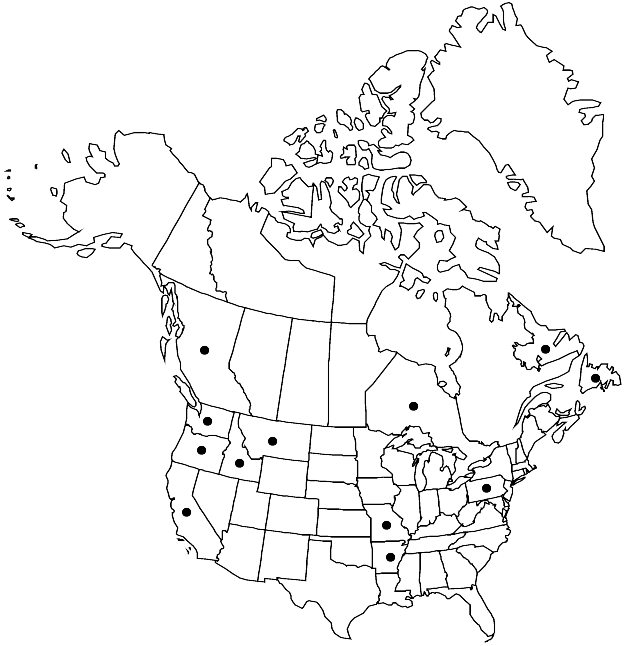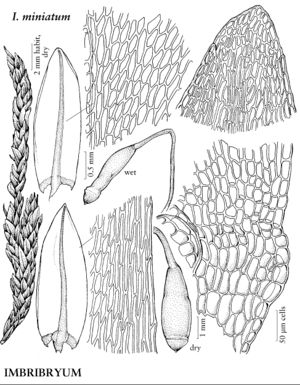Difference between revisions of "Imbribryum miniatum"
Phytologia 89: 112. 2007.
FNA>Volume Importer |
FNA>Volume Importer |
||
| Line 30: | Line 30: | ||
|elevation=low to moderate elevations (0-1500 m) | |elevation=low to moderate elevations (0-1500 m) | ||
|distribution=B.C.;Nfld. and Labr.;Ont.;Ark.;Calif.;Idaho;Mo.;Mont.;Oreg.;Pa.;Wash.;Atlantic Islands (Faroe Islands). | |distribution=B.C.;Nfld. and Labr.;Ont.;Ark.;Calif.;Idaho;Mo.;Mont.;Oreg.;Pa.;Wash.;Atlantic Islands (Faroe Islands). | ||
| − | |discussion=<p>Imbribryum miniatum is a distinctive species, with dark red-purple, julaceous stems, oblique and strongly incrassate distal laminal cells, and pigmented inflated cells across the leaf base. Some collections from Yosemite National Park are remarkably large in stature, with dark green leaves that become nearly black when dry. They may represent an undescribed variety or species. Imbribryum miniatum appears to be related to several Southern Hemisphere and tropical species, including those called Bryum crassum (Australasia), B. perconcavifolium (Mexico-Central America), B. recurvulum (southeast Asia), and B. sclerodictyon (New Guinea).</p> | + | |discussion=<p><i>Imbribryum miniatum</i> is a distinctive species, with dark red-purple, julaceous stems, oblique and strongly incrassate distal laminal cells, and pigmented inflated cells across the leaf base. Some collections from Yosemite National Park are remarkably large in stature, with dark green leaves that become nearly black when dry. They may represent an undescribed variety or species. <i>Imbribryum miniatum</i> appears to be related to several Southern Hemisphere and tropical species, including those called <i>Bryum</i> crassum (Australasia), B. perconcavifolium (Mexico-Central America), B. recurvulum (southeast Asia), and B. sclerodictyon (New Guinea).</p> |
|tables= | |tables= | ||
|references= | |references= | ||
| Line 54: | Line 54: | ||
|publication year=2007 | |publication year=2007 | ||
|special status=Selected by author to be illustrated | |special status=Selected by author to be illustrated | ||
| − | |source xml=https://jpend@bitbucket.org/aafc-mbb/fna-data-curation.git/src/ | + | |source xml=https://jpend@bitbucket.org/aafc-mbb/fna-data-curation.git/src/8f726806613d60c220dc4493de13607dd3150896/coarse_grained_fna_xml/V28/V28_233.xml |
|genus=Imbribryum | |genus=Imbribryum | ||
|species=Imbribryum miniatum | |species=Imbribryum miniatum | ||
Revision as of 17:04, 18 September 2019
Plants medium-sized, dark red to red-green, rarely green, sometimes purple-black. Stems 2–4(–5) cm, strongly julaceous, with metallic sheen, older stem sometimes densely radiculose. Leaves rigid, strongly imbricate when dry, purple-red to brown-red, rarely dull olive green, ovate, strongly concave, (1–)2–3 mm; base not or weakly decurrent; margins plane throughout or rarely revolute proximally, entire to finely serrulate distally, limbidium absent; apex rounded-obtuse to broadly acute, cucullate; costa red-brown to brown, percurrent, awn absent; basal laminal cells somewhat inflated, pigmented, in 2 or 3 rows; proximal cells abruptly quadrate, with scattered short-rectangular cells, 1–2:1; medial and distal cells elongate-rhomboidal, (40–)50–60 × (10–)12–14 µm, 4–6:1, walls strongly incrassate, arranged in rows oblique to costa at 30–45° angle. Specialized asexual reproduction absent. Seta ± straight to flexuose, red, red-brown, or purple. Capsule inclined to nutant, red-purple, pyriform, 2–4(–5) mm, neck long. Spores 14–18 µm, smooth to papillose, yellow-brown.
Phenology: Capsules mature spring–summer.
Habitat: Damp to wet siliceous rock, soil over rock, associated with waterfalls or springs
Elevation: low to moderate elevations (0-1500 m)
Distribution

B.C., Nfld. and Labr., Ont., Ark., Calif., Idaho, Mo., Mont., Oreg., Pa., Wash., Atlantic Islands (Faroe Islands).
Discussion
Imbribryum miniatum is a distinctive species, with dark red-purple, julaceous stems, oblique and strongly incrassate distal laminal cells, and pigmented inflated cells across the leaf base. Some collections from Yosemite National Park are remarkably large in stature, with dark green leaves that become nearly black when dry. They may represent an undescribed variety or species. Imbribryum miniatum appears to be related to several Southern Hemisphere and tropical species, including those called Bryum crassum (Australasia), B. perconcavifolium (Mexico-Central America), B. recurvulum (southeast Asia), and B. sclerodictyon (New Guinea).
Selected References
None.
